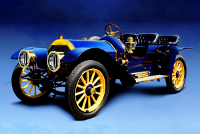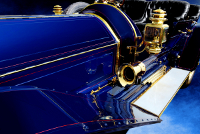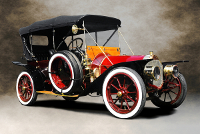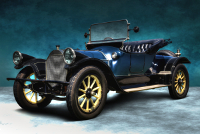Location:
Radnor Hunt Concours d'Elegance, 2016
Owner: Theodore L. Reimel, III | Wayne, Pennsylvania
Prologue:
Trundling through a wealth of brass era Pierce-Arrow data, I've been able to close the loop on a note RM Sotheby's writes in their auction description. Chassis #7450 is pictured in Marc Ralston's 1984 pictorial, but erroneously identified as a 1909 model. When Ralston's book hit my desk, I could see for myself what all the fuss was about. The photograph dates from the early 1980s, as opposed to the period Pierce-Arrow factory photographs around which the pictorial is based. So the photo is a nice color print depicting the car in black with polished panels on the bonnet, a full windscreen, and an attached hood in the retracted position. I had expected a simple error captioning an old monochrome print, not a late color image of a now-lost variation. So with some extra stock, I may attempt an illustration of this lost version. But for the time being, I'm happy with this deep blue gallery.
- - - - - - - - - -
► Image Source: Nikon D750 (24.3 MP)
References:
- Ralston, Marc. "Pierce-Arrow" A.S. Barnes & Co., Inc., San Diego, CA. 1980, page 63-64, 230
- Ralston, Marc. "Pierce-Arrow, The Golden Age" Jostens Publications, Clarksville, TE. 1984, page 33, 82
- RM Sotheby's: The auction description prepared for the Andrews Collection sale in Fort Worth, Texas.
1910 is an important year for Pierce-Arrow. The line now consists of the 36-UU, 48-SS, and 66-QQ, having cleaned up the clutter of 1909. Simplicity will allow Pierce-Arrow to take an already superior product and develop each model into its absolute best version. 1910 is also the first year for the power air pump, driven by a take-off from the transmission, a wonderfully helpful tool for long-distance touring in an age whose tyre performance greatly lagged.
The only known 1910 48-SS Demi-Tonneau to survive, RM Sotheby's describes chassis #7540 as a variation on the five-passenger touring car, creating a four-passenger roadster with its narrowed, close-coupled seating compartment. Let the omission of a windscreen help us notice the car's sportier aspect. Elongated front fenders dissolve some of the wheelbase, with a fly-away rear fender, creating an altogether powerful stance. With 48 horsepower, a four-speed manual transmission, and much little less wind resistance than standard, this car would be rapid any day of the week. Pierce cars remain among the rare cars of the brass era that can cruise at modern speeds.
Chassis #7540 is mostly original, with only the front fenders having been refabricated. The car was originally sold to a New Jersey owner, Stewart Cook, who kept the car until his death in 1966. Subsequently, chassis 7540 lived in the care of east coast and California-based enthusiasts. The condition of the paint is very good, even glowing, while the interior is admirably worn in the spirit of the best long-distance Pierce-Arrow tourers.
Motor: 8,603 cc (525 cubic inch) straight 6-cylinder in three cast iron blocks | 114.3 mm x 120.65 mm (4½" x 4¾")
Valvetrain: T-head, single plug
Power: 48 rated @ 1,600 rpm
Drivetrain: floor-shift, four-speed selective sliding-gear manual transmission, rear-wheel drive
Front Suspension: semi-elliptical leaf springs
Rear Suspension: live axle with semi-elliptical leaf springs
Architecture: cast alloy body on pressed manganese steel rear-drop frame
Kerb Weight: 1,868.8 kg (4,120 lbs), though probably lighter given the close-coupled coachwork
Wheelbase: 3,416.3 mm (134.5 inches)
Etymology:
In 1910, Pierce-Arrow simplified its offerings among the 36-UU, 48-SS, and 66-QQ models; all are 6-cylinders and each of the number designations corresponds to rated horsepower. 'Tonneau' is carriage-speak for an open passenger section, and translates to 'barrel' in French. The style of this car has been called a demi-tonneau, mini-tonneau, and toy tonneau. Demi-tonneau might be the most accurate, literally meaning 'half barrel,' or perhaps semi-open. If in any measure the name applies to these brass era Pierce-Arrow cars, the main difference is the height and curve of the bulkhead, which we can see on this 1910 model is greatly pronounced. A touring model would instead use a broader, flatter bulkhead.
In 1909, the 48-SS succeeded the 40-S of late 1908. The number indicates horsepower, whereas the doubled letter seems to indicate a revised model version. The 48-SS survived 1910's revised format, whereas Pierce discontinued the 40-S and 40-PP.
Figures:
Pierce-Arrow produced 817 Model 48-SS cars in 1910. This car, chassis #7450, is the only surviving 48-SS Demi-Tonneau.
Value:
In May of 2015, chassis #7540 sold at RM Sotheby's auction at Fort Worth, Texas for $852,500.
Sporting Four: The Four-Place Runabout, a Rare Configuration
Big but lean, the Demi-Tonneau features a narrow, close-coupled passenger compartment, turning a five-passenger touring car into a four-passenger sports touring configuration. RM Auctions provided a separate windscreen in its May 2015 sale, (likely the unit depicted in Marc Ralston's 1984 pictorial), but the spirit of this 48-SS is its performance, and it suits the car to go without. Speed isn't uncommon to Pierce-Arrow cars; their power and engineering strength is sufficient to have placed them in the top percentile of early automobiles. But speed was seldom the selling point.
In early Pierce-Arrow tradition, this 1910 car is right-hand drive. Body panels are cast alloy, cold-riveted together, with wood bracing added for stiffness and a plethora of brass fittings and fixtures filling in the seams.
Barrel Shape: Identifying the Tonneau by the Bulkhead
Note the high-hump shape of the bulkhead on chassis #7450. Touring cars use a broader, flatter bulkhead whereas the tonneau uses more curvaceous lines, much in the spirit of the barrel after which the style takes its name. The beautiful pommel at the head of this 1910 model is best enjoyed free of a windscreen, which would hide the curve and distort the flow of line into the open compartment. (As noted, Ralston's 1984 book, "Pierce-Arrow: The Golden Age," depicts this car with windscreen and hood, misidentified as a 1909 model.)
Period Accessories: Detachable Rims and the Gabriel Exhaust Whistle
Note that our portraits offer closer looks at the Firestone detachable rims that are standard fare for many cars of the era. Also intriguing, fitted above the running boards is a three-pipe Gabriel exhaust whistle, which uses an exhaust cut-out to power the pipes. More elaborate versions of these horns could play different tunes, connected to keyboards in the cabin; this three-pipe whistle may be more limited. New for 1910, the enclosed splash pan between the running board and body makes the pipe whistle installation possible.
Last Updated: Mar 26, 2025







